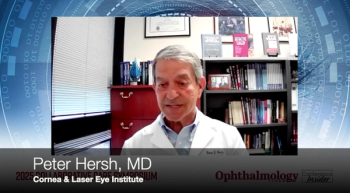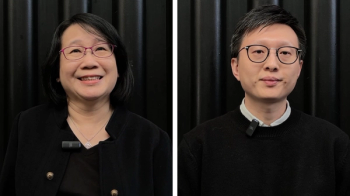
ASCRS task force looks at ways ophthalmologists, optometrists can collaborate
The formation of a new organization to represent all eye-care practitioners is one of the possibilities being considered by a task force examining ways that ophthalmologists and optometrists can collaborate to provide patient care.
Fairfax, VA-The formation of a new organization to represent all eye-care practitioners is one of the possibilities being considered by a task force examining ways that ophthalmologists and optometrists can collaborate to provide patient care.
The group also will assess member needs and consider creating new educational tracks at the existing American Society of Cataract and Refractive Surgery (ASCRS) annual meeting.
Two ophthalmologists and five optometrists will make recommendations to ASCRS leadership as part of the ASCRS Integrated Ophthalmic–Managed Eye Care Delivery (IOMED) Task Force, which also includes a representative of ASCRS.
“The goal of the task force is to find and present the best possible ways to facilitate cooperation between ophthalmologists and optometrists so that we are prepared to meet the needs of the 77 million American baby boomers nearing the age of 65,” said Stephen S. Lane, MD, of St. Paul, MN, the ASCRS Governing Board member who is leading the group. “Today and in the future, high-quality eye care will require a patient-centric, integrated eye-care model in which ophthalmologists, optometrists, technicians, opticians, and managers work together in a dynamic setting. I believe we have assembled a superb team that is capable of addressing the challenge.”
Other task force members:
• Howard Fine, MD, Oregon Eye Associates, Eugene, OR;
• Douglas D. Koch, MD, Baylor College of Medicine, Houston, TX;
• Jeff Azus, OD, Altos Eye Physicians, Los Altos, CA, and Kaiser Permanente, San Francisco;
• Marlane J. Brown, OD, FAAO, Minnesota Eye Consultants, Minneapolis;
• Derek N. Cunningham, OD, FAAO, Dell Laser Consultants, Austin, TX;
• Richard C. Edlow, OD, Katzen Eye Group, Lutherville, MD;
• David I. Geffen, OD, FAAO, Gordon Weiss Schanzlin Vision Institute, San Diego; and
• David A. Karcher, executive director of ASCRS, Fairfax, VA.
The IOMED eye-care delivery model, according to ASCRS, is endorsed by the organization’s executive committee and governing board and encourages arrangements in which optometrists employed by ophthalmologists, as well as optometrists employed by the military or industry, play a role in the delivery of non-surgical eye care.
“This patient-centered model encourages greater efficiency and coordination of care with ophthalmologists and optometrists working together to meet the growing demands for service and address the pending changes in Medicare and general healthcare delivery,” according to a statement from the organization.
In other news, the Contact Lens Association of Ophthalmologists (CLAO) will be managed under the administrative umbrella of ASCRS as of Aug. 15, joining the ASCRS Foundation, the American Society of Ophthalmic Administrators, and the Cornea Society, which are similarly managed. Joyce D’Andrea, who has served as ASCRS clinical coordinator since 2005, will assume responsibilities as the CLAO staff liaison.
ASCRS has about 9,000 members. CLAO is trying to increase its membership from its current level of about 300 members and also seeks to expand its educational offerings as it launches a new vision for its future.
“This is an exciting opportunity for CLAO to grow and emerge as a stronger, more vibrant community of ophthalmological professionals dedicated to the science of contact lenses,” said CLAO President Warren R. “Chip” Fagadau, MD.
CLAO was founded in 1963, and its first scientific program was held the following year during the annual meeting of the American Academy of Ophthalmology and Otolaryngology. Since then, CLAO has grown to focus on education and professional support for office-based ophthalmologists, optometrists, and other contact lens professionals.
“CLAO has had long-standing and productive relationships with ophthalmology’s major organizations. We look forward to strengthening those bonds in the years to come as ophthalmologists increasingly recognize the clinical significance of new contact lens technology in the continuum of vision care,” Dr. Fagadau said. “Furthermore, we’ll look to broaden our already established interaction with a number of international contact lens societies. All of these initiatives, we feel, can be advanced through the support of ASCRS.”
In addition to its peer-reviewed scientific journal, Eye and Contact Lens: Science and Clinical Practice, CLAO also offers educational programming, professional development, and an annual meeting. Under the arrangement, the CLAO Education and Research Foundation also will be managed by ASCRS. CLAO’s annual meeting and its publications will remain independent, and the organization will continue to function under its current bylaws and leadership board, with the sole addition of an ASCRS representative.
ASCRS President David F. Chang, MD, thanked Dr. Fagadau and Edward Holland, MD, immediate past president of ASCRS, for their efforts in forging the new arrangement.
“I believe that this management support and collaboration will benefit CLAO members and their patients, and we’re excited to help the organization grow and meet its educational mission for many years to come,” Dr. Chang added.
For more articles in this issue of Ophthalmology Times eReport,
Newsletter
Don’t miss out—get Ophthalmology Times updates on the latest clinical advancements and expert interviews, straight to your inbox.













































